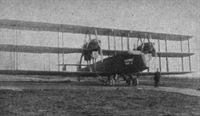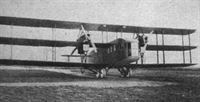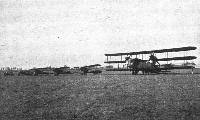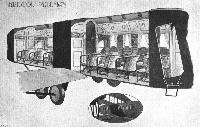
Описание
Страна : Великобритания
Год : 1918
Тяжелый бомбардировщик-триплан
Bristol Type 24 и 25 Braemar, Type 26 и Type 37 Tramp
Первый из двух дальних тяжелых бомбардировщиков-трипланов Bristol Type 24 Braemar, созданных в конце Первой мировой войны для ударов по территории Германии, поднялся в воздух 13 августа 1918 года. Этот огромный самолет с фюзеляжем прямоугольного сечения имел деревянную расчалочную конструкцию с полотняной обшивкой, бипланное горизонтальное оперение и четырехколесные основные стойки шасси. Силовую установку первоначально планировалось разместить в фюзеляже. В конечном итоге, четыре рядных двигателя Siddeley Puma мощностью по 230 л.с. (171 кВт) установили тандемно на среднем крыле. Поскольку на самолете изначально хотели использовать моторы Rolls-Royce Eagle, развивавшие 360 л.с. (268 кВт), мощность силовой установки была недостаточной, и летные характеристики Braemar Mk I оказались низкими. Самолет использовался в экспериментальных работах и в 1920 году был пущен на слом. Второй прототип, Type 25 Braemar Mk II, оснащенный двигателями Liberty, поднялся в воздух 18 февраля 1919 года, когда надобность в тяжелых бомбардировщиках уже отпала. Эту машину использовали для испытаний, пока она не попала в аварию в конце 1920 года.
Третий Braemar достроили уже в варианте Type 26 Pullman - 14-местного пассажирского самолета. Несмотря на проведенные в 1920 году испытания, самолет впоследствии разобрали. В последней попытке фирма пыталась реализовать идеи, заложенные в первоначальном проекте. Были построены два экземпляра самолета Type 37 Tramp, силовая установка которого размещалась внутри фюзеляжа и состояла из четырех двигателей Puma. Проблемы с трансмиссией, связывающей моторы с винтами, были так велики, что Tramp так и не поднялся в воздух. Самолет Tramp Boat с паротурбинной силовой установкой так и остался в проекте.
ТАКТИКО-ТЕХНИЧЕСКИЕ ХАРАКТЕРИСТИКИ
Bristol Type 25 Braemar Mk II
Тип: тяжелый бомбардировщик-триплан
Силовая установка: 4 двигателя жидкостного охлаждения Liberty 12 мощностью по 400 л. с. (298 кВт)
Летные характеристики: максимальная скорость 196 км/ч на оптимальной высоте; потолок 5180 м
Масса: пустого 5084 кг; максимальная взлетная 7490 кг
Размеры: размах крыла 24,89 м; длина 15,70 м; высота 6,30 м; площадь крыла 176,97 м2
Вооружение (проектное): два 7,7-мм пулемета Lewis на турели в носовой части и два аналогичных пулемета на турели в верхней стрелковой точке; одна 1497-кг бомба, или шесть 104-кг или 113-кг бомб, или 12 51-кг и пять 18-кг бомб на внутренней подвеске
Описание:
- Bristol Type 24 и 25 Braemar, Type 26 и Type 37 Tramp
- Flight, December 1919
THE PARIS AERO SHOW 1919 - Flight, July 1920
The Olympia Aero Show 1920
Фотографии
-
Мировая Авиация 75
Регистрационный номер: C4298 [4] Этот Type 26 Pullman, принадлежавший Военно-воздушному комитету (Air Board), в 1920 году проходил испытания в Мартлешем Хит.
-
Aeroplane Monthly 1990-11 / J.Stroud - Wings of Peace
Регистрационный номер: C4297 The Bristol Braemar Mk II, from which the Pullman was developed.
-
Flight 1940-02 / Flight
The Braemar Bomber was a triplane with 4 Puma engines. 1918
-
Flight 1939-03 / Flight
The “Braemar” was a bomber of 18,000 lb. gross weight.
-
Flight 1940-02 / Flight
The Bristol Pullman was a civil version of the Braemar. 1919
-
Flight 1920-07 / Flight
The Bristol "Pullman" triplane in flight
-
Aeroplane Monthly 1990-11 / J.Stroud - Wings of Peace
A very rare flying view of the Bristol Pullman.
-
Flight 1919-12 / Flight
Регистрационный номер: C4298 [4] THE BRISTOL PULLMAN: This machine has a cabin seating 14 passengers.
-
Aeroplane Monthly 1990-11 / J.Stroud - Wings of Peace
Регистрационный номер: C4298 [4] The Pullman was designed to carry 14 passengers and two crew but was never operated as a passenger aircraft although the photograph would lead one to believe otherwise. This photograph of the Pullman, with mailbag, “passengers" and uniformed attendant, was probably taken for publicity purposes. The aircraft was dismantled in 1920.
-
Flight 1939-03 / Flight
Регистрационный номер: C4298 [4] -
Flight 1920-04 / Flight
The Bristol "family" at Home. Left to right: The Bristol Babe, the Bristol monoplane, the Bristol Badger, the Bristol Fighter, the Bristol Tourer and the Bristol Pullman triplane
Другие самолёты на фотографии: Bristol Babe - Великобритания - 1919Bristol F.2A/F.2B Fighter - Великобритания - 1916Bristol F.2C / Badger - Великобритания - 1919Bristol M.1A / M.1B / M.1C - Великобритания - 1916Bristol Tourer - Великобритания - 1919
-
Flight 1939-03 / Flight
The Bristol “family” of 1920. From left to right the types are the Tourer, the Scout type F, the Babe, the monoplane, and the “Brisfit.” Behind them all is the huge Pullman passenger-carrier.
Другие самолёты на фотографии: Bristol Babe - Великобритания - 1919Bristol F.2A/F.2B Fighter - Великобритания - 1916Bristol M.1A / M.1B / M.1C - Великобритания - 1916Bristol Scout E / F - Великобритания - 1918Bristol Tourer - Великобритания - 1919
-
Flight 1920-07 / Flight
GIANT AT OLYMPIA: The Bristol Pullman triplane with four engines. In spite of its size the Pullman has an extraordinary turn of speed
-
Aeroplane Monthly 1990-11 / J.Stroud - Wings of Peace
Регистрационный номер: J6912 J6912, the first Bristol Tramp.
-
Flight 1939-03 / Flight
The large triplane shown here was known as the “Tramp.” It had four Puma engines in the fuselage.
-
Aeroplane Monthly 1990-11 / J.Stroud - Wings of Peace
The Bristol Pullman under construction in June 1919.
-
Flight 1939-03 / Flight
The large triplane shown here was known as the “Tramp.” It had four Puma engines in the fuselage.
-
Aeroplane Monthly 1990-11 / J.Stroud - Wings of Peace
The rear cabin of the Bristol Pullman.
-
Flight 1919-12 / Flight
THE BRISTOL PULLMAN: Photo shows one end of the cabin. Owing to lack of space on their stand, the Bristol firm are prevented from showing the actual machine, but a very fine scale model will be on view.
-
Flight 1939-03 / Flight
The Bristol Pullman triplane had accommodation for fourteen passengers in great comfort.
-
Flight 1920-11 / Flight
MODERN CABIN MACHINES: The Bristol Pullman Triplane. Note division of cabin into separate compartments with corridor.
-
Flight 1920-07 / Flight
SOME BRISTOL FITTINGS: The sketch on the left show the strut attachments on the Pullman. On the right is seen the tail skid of the Pullman
-
Flight 1920-07 / Flight
The under-carriage of the Bristol Pullman
-
Flight 1919-12 / Flight
The Bristol Pullman, four 410 h.p. Liberty engines
- Фотографии























